Table of Contents
Is there anything more annoying than a desperate stomach growling? Hunger can really make your day miserable and fighting it gets even more complicated if you’re trying to lose weight. Fortunately, as long as you stay in a calorie deficit, you don’t have to worry about this. If you choose the right foods, you can be well-fed and at the same time maintain a lower energy intake. Today’s article will tell you more about these foods.
What is important for weight loss?
The cornerstone of every successful weight loss story is a calorie deficit. In order to burn body fat and gradually reduce body weight, your energy intake must be lower than energy expenditure for a long time. Only then will your body draw energy from its reserves. If you would like to know what is your recommended energy intake, our online calculator can help you figure it out.
Even though it initially looks quite simple, this process can get complicated by hunger or sweet cravings. These problems are the common reason why people give up the desire for a slimmer body and for losing weight in general. Fortunately, these problems can be prevented or at least mitigated by concentrating on the following changes:
- Focus on the regularity of your diet.
- Make sure you get enough protein and fibre.
- Don’t neglect your intake of liquids.
- Also, focus on stress management and on the quality and length of your sleep. It’s not for nothing that sleep is considered the most effective fat burner.
- It is also important to learn to listen to your body and respond correctly to feelings of hunger and satiety. Eating slowly, concentrating on the food or chewing each bite properly can help you not to overeat and finish eating when you are approximately 80% full, which is the ideal state.
If you are further interested in what you should focus on when losing weight and how to actually do it, read our article 10 Tips to Lose Weight Easier and Get in Shape.
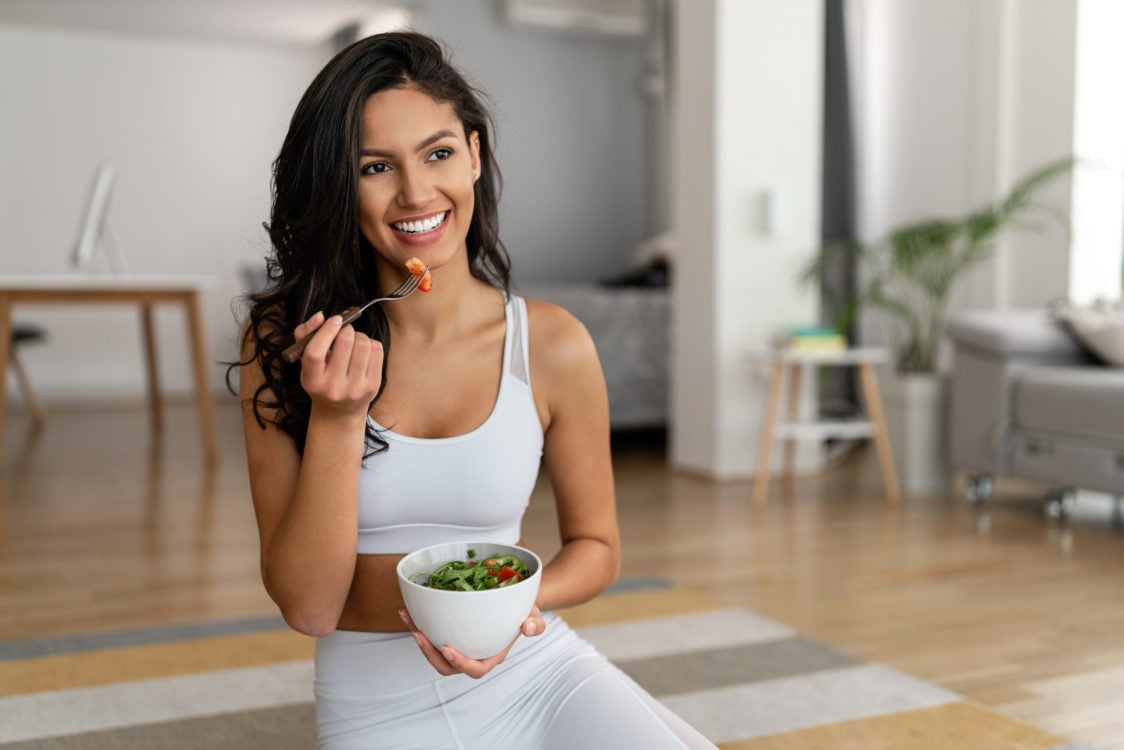
What foods to eat when losing weight?
Factors such as sufficient sleep or regularity in the diet are the fundamental pillars of your success. However, you must also focus on choosing the right foods to help you avoid the aforementioned hunger and unpleasant cravings for sweets.
Your goal should be to regularly include foods that will allow you to eat sensibly and enjoyably, but at the same time will help you remain in a calorie deficit. In general, these are foods that have a relatively small amount of energy, but at the same time a large volume. In other words, these are foods that have so-called low energy density. They are typical for their high content of water, fibre, protein and at the same time low fat content. They are also often rich in micronutrients (minerals, vitamins, etc.), which is why they are considered a high nutritional density food. [20]
Let’s compare, for example, 100 g of milk chocolate and 100 g of raspberries.
- While chocolate has about 530 kcal, the same amount of raspberries has only about 46 kcal.
Chocolate has a much higher energy density compared to raspberries, as it contains up to 484 kcal more in the same amount. At the same time, it also doesn’t provide you with almost any vitamins or minerals, and therefore we can say that it has a low nutritional density.
The same doesn’t apply to raspberries, which are rich in many micronutrients as well as fibre. They have a high nutritional density and, given such a small amount of energy (46 kcal / 100 g), a low energy density.
However, it is necessary to remember that even when on a diet you should not choose only foods with low energy density. They should serve as a regular part of your diet, which will supply you with important nutrients and satiate you effectively. However, a healthy diet, including a diet for weight loss, also includes nutritionally rich foods with a higher energy content (good examples are, for example, nuts and seeds or other sources of healthy fats). It is therefore necessary to individually determine the right ratio for each person. [20]
If you are still not sure how to compose a diet plan properly, you can find some inspiration in our article What Is a Healthy Diet and How to Learn to Eat Healthily?

How to tell which foods can satiate well?
There are certain indicators that can help you determine how well the food satiates and fills an empty stomach. These factors are included, for example, in the following ratings.
- The satiety index (given in %) was created on the basis of a study that evaluated how individual foods satiate its participants. Bread made from white wheat flour (satiety index 100%) was used as a reference food with which all others were compared. The higher the resulting value of the food index, the more satiating this food is. Research has shown that foods with the highest weight are the most satiating and satisfying. Based on this, the recommendation was made that when losing weight, you should mainly choose those foods with the greatest possible weight and at the same time the lowest possible amount of calories. These are foods with the already mentioned low energy density, which have a large volume but a small amount of calories. [18]
Satiety index of some foods
Satiety Index | |
|---|---|
| Tuna | 225 % |
| Cod | 225 % |
| Cooked Potatoes | 323 % |
- The satiety factor also takes into account other criteria, because over time it was found that the energy density alone is not enough to determine the ability of food to satiate. In addition to the weight of the food itself, this factor also takes into account its nutrient content. The value of a food’s satiety factor can be determined using an equation that takes into consideration the content of protein, fibre, and also fat. Foods can receive a factor value between 0-5, where the higher the value, the more satiating the food. For example, watermelon has a satiety factor of about 4.5, while butter, which is about 80% fat, has only 0.5. [18]
Satiety factor of some foods
| Watermelon | 4.5 |
| Greek Yoghurt | 2.5 g |
| Fish | 3.5 |
| Cooked Potatoes | 2.6* |
| Zucchini | 4.2* |
*the stated value is estimated based on available data

Which foods are low in calories but fill you up well?
There is a relatively large number of foods that boast a large volume, low caloric value and at the same time a sufficient amount of fibre or protein. Let’s take a look at some of them and explain why they are a good choice.
1. Low-fat quark
Quark is satiating, mainly due to its high protein content. It contains up to 12 g of protein per 100 g and, for example, a whole 250 g package of quark can easily supply you with 30 g of protein.
Protein has the highest satiating capacity of all nutrients, so every snack with a portion of quark ensures that your stomach doesn’t growl from hunger after a while. High-fat or semi-fat quark is also satiating, but with them, you have to count on a lower amount of protein (9-10 g / 100 g) and a higher fat content, i.e. a larger amount of calories. [6]
The good satiating ability of quark is also supported by the type of protein it contains. Unlike whey proteins, casein proteins are digested more slowly, at a rate of approximately 6 g/hour. For comparison, the rate of digestion of whey protein is about 10 g/hour. The whole process of digestion and absorption of quark is therefore slowed down, which prolongs the feeling of satiety. This is also why casein proteins, which are also called night proteins, are so popular. [1,6]
How much energy and nutrients does quark contain?
| Energy Value | 69 kcal / 290 kJ | 90 kcal / 378 kJ | 131 kcal / 550 kJ |
| Protein | 12 g | 10 g | 9 g |
| Carbohydrates | 4 g | 4 g | 3.5 g |
| Fats | 0.5 g | 3.8 g | 9 g |
| Fibre | 0 g | 0 g | 0 g |
How to include quark in your diet?
- When you prepare yoghurt with fruit and granola, mix in some quark. This will increase the amount of protein in the food.
- With the help of quark, you can also add extra protein to various cakes and desserts.
- Quark is also suitable as an ingredient that can make smoothies or various milkshakes taste smoother.
- It’s also great for preparing various dips and sauces.
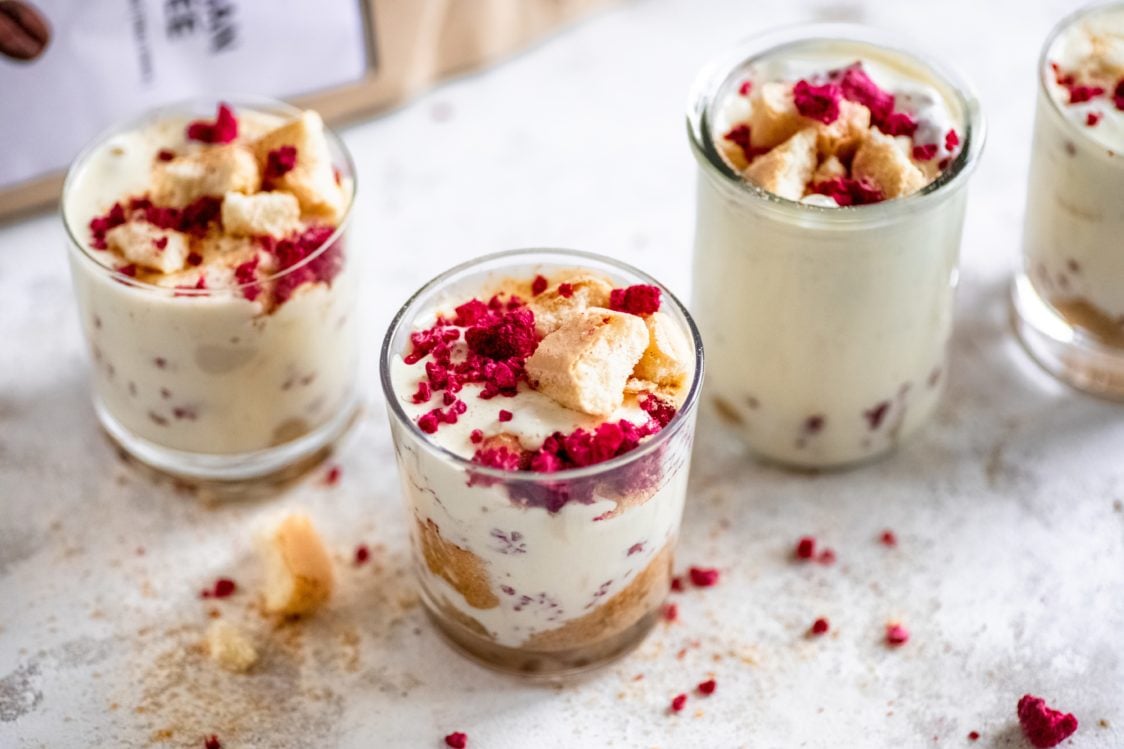
2. Skyr
Skyr is a traditional Icelandic dairy product, which is similar to quark in its taste, consistency and nutrient content. Like low-fat quark, skyr has approximately 12 g of protein per 100 g. Thanks to the fact that it contains almost no fat, it also has a very low energy value. A regular 150 g package contains only around 100 kcal.
A snack consisting of skyr and, for example, a smaller banana will drive away hunger and add protein and fibre, while having only about 190 kcal. In addition, this meal will also supply you with a load of calcium, because dairy products contain a lot of it. There are about 130 mg of calcium in 100 g of skyr, which is about an eighth of the daily recommended dose for a healthy adult. This will benefit your bones, teeth and joints. [7,16]
How much energy and nutrients does skyr contain?
| Energy Value | 65 kcal / 273 kJ |
| Protein | 12 g |
| Carbohydrates | 4 g |
| Fats | 0.1 g |
| Fibre | 0 g |
How to include skyr in your diet?
- Thanks to its similar consistency to quark, it can be used as its substitute.
- It’s also excellent just plain with some fruit and oats or muesli as a light snack.
You might be interested in these products:
3. Greek yoghurt
Thanks to a different production method, Greek yoghurt has a higher protein content than classic plain yoghurt, namely 10 g/100 g. If you choose the one with low fat content, it will also have a very low energy value. Greek yoghurt made from skimmed milk with almost zero fat content has an average of only 57 kcal/100 g.
In addition to protein, it also supplies your body with the aforementioned calcium or, for example, vitamin B2 (riboflavin), which is beneficial for your eyes and nervous system. If you add to it, for example, oats or mix it into porridge, you get food rich in proteins, complex carbohydrates and fibre. [16,17]
How much energy and nutrients does Greek yoghurt contain?
| Energy Value | 57 kcal | 100 kcal |
| Protein | 10 g | 8.4 g |
| Carbohydrates | 3.5 g | 4.6 g |
| Fats | 0.3 g | 5.3 g |
| Fibre | 0 g | 0 g |
How to include Greek yoghurt in your diet?
- You can replace classic white yoghurt with Greek yoghurt, or even mix them together.
- Similar to quark, Greek yoghurt can also be used to make a tasty dip to add some variety to your meal.
- You can also use it to make a salad dressing. When you partially replace classic yoghurt with Greek yoghurt, the amount of protein increases.

4. Tuna
Like all fish, tuna is a rich source of protein and therefore can induce a feeling of satiety. There are about 25 g of protein in 100 g of tuna steak. However, compared to other sea fish, it has one advantage, and that is very low fat content of around 0.5 g/100 g. Thanks to this, its total energy value is also low (approx. 103 kcal / 100 g) and is thus food that is convenient when losing weight.
You can buy tuna fresh, but you don’t have to be afraid of canned tuna either. However, you have to be careful about choosing the right canned food. If your goal is to choose a version with the lowest possible amount of energy, you should choose tuna in brine. The one in oil can in some cases have four times the energy value (depending on the amount of added oil).
Tuna is rich in vitamin B12, which is important for the proper formation of red blood cells and the function of the nervous system. It also provides vitamin D, which is important for your bones and immune system, as well as vitamin A, which is essential for good eyesight. [16,17]
How much energy and nutrients does tuna contain?
| Energy Value | 103 kcal / 433 kJ | 100 – 140 kcal | 170 – 400 kcal |
| Protein | 24.5 g | 20 – 25 g | 20 – 25 g |
| Carbohydrates | 0 g | 0 g | 0 g |
| Fats | 0.5 g | 0.5 – 5 g | 4 – 35 g |
| Fibre | 0 g | 0 g | 0 g |
How to include tuna in your diet?
- Tuna steak is excellent on its own with a simple side dish, for example potatoes or sweet potatoes and vegetables.
- Canned tuna can be used to make a tasty spread or, for example, a tuna salad.
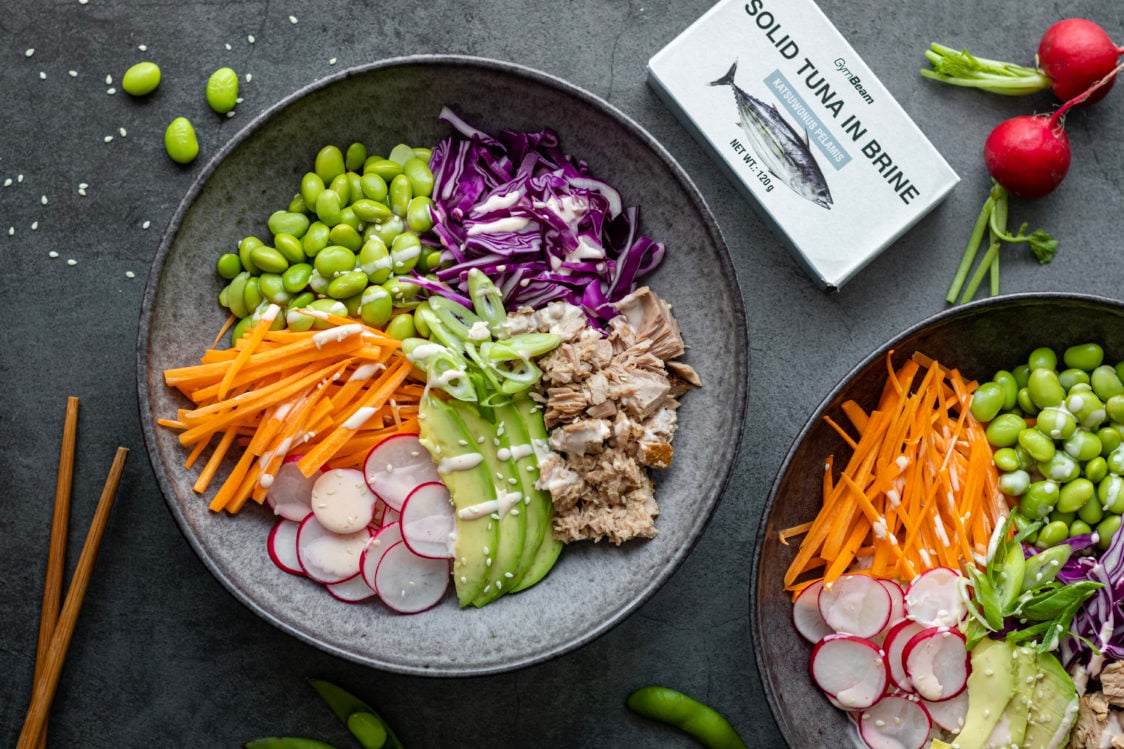
5. Cod
Cod is also among the fish that is characterized by a low amount of fat and energy. It even has fewer calories than tuna, roughly 73 kcal/100 g. Just for comparison, 70 g of tuna has a similar energy value to 100 g of cod. [2,12]
Like other animal foods, cod is a good source of vitamin B12. It also contains a significant amount of potassium and phosphorus. [16]
Cod is also interesting because of its low mercury content. That can alleviate stress about a high intake of this heavy metal due to its regular appearance in the diet. This can be a problem especially with large fish such as shark or swordfish. Even the aforementioned tuna contains certain levels of mercury, but if it’s just a part of a balanced and varied diet, you don’t have to worry about it. [4,12]
How much energy and nutrients does cod contain?
| Energy Value | 73 kcal |
| Protein | 18 g |
| Carbohydrates | 0 g |
| Fats | 0.1 g |
| Fibre | 0 g |
How to include cod in your diet?
- You can bake it or prepare it in a pan and serve it with a side dish according to your preferences. A delicious meal is ready in a few minutes.
- You can make the neutral taste of cod more interesting with different marinades, for example this lemon one.
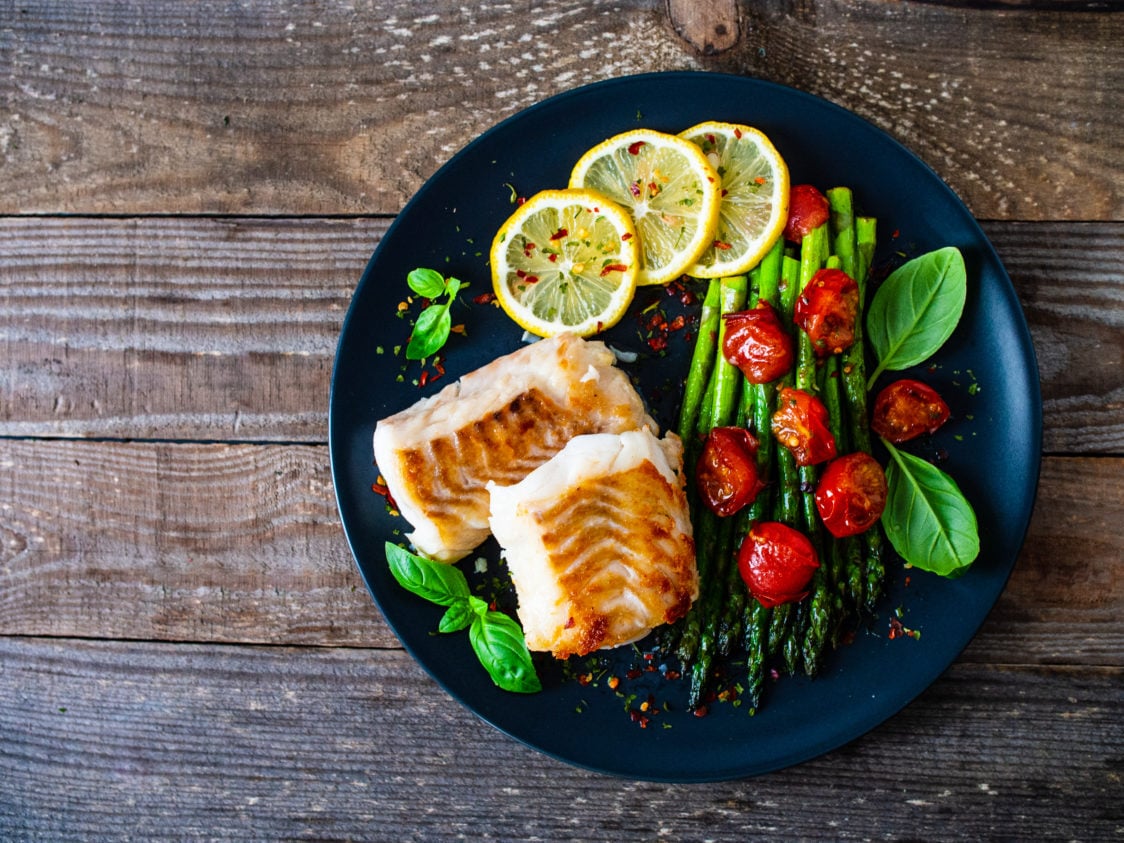
6. Potatoes
Potatoes have a surprisingly low energy content, approximately 76 kcal / 100 g. This is due to the fact that they belong to vegetables and, unlike other carbohydrate foods, contain only about 16 g of carbohydrates / 100 g. A large proportion of potatoes is made up of water, which represents up to 79% of their content. [8,16]
If you wanted to compare how satiating a serving of potatoes with 50 g of carbohydrates would be in comparison with a portion of white rice with the same amount of carbohydrates, you would probably find that the potatoes win. Such a portion of potatoes has around 310 g (in raw state), while you could indulge in only about 63 g of rice (in raw state). The weight of rice roughly doubles after cooking, but even still, the potatoes lead the way. Research also confirms that potatoes probably have a greater satiating capacity than other carbohydrate foods (rice, bread, etc.) [13,16]
These popular tubers are also a good source of vitamin C, which has antioxidant effects, and they also contain, for example, a significant amount of potassium and magnesium. These minerals are necessary for normal muscle and nervous system function. [13,17]
How much energy and nutrients do potatoes contain?
| Energy Value | 76 kcal / 319 kJ |
| Protein | 2 g |
| Carbohydrates | 16 g |
| Fats | 0.01 g |
| Fibre | 2 g |
| Water | 79 g |
How to include potatoes in your diet?
- You can prepare them, as most people do, as a side dish to meat or fish. For example, try our recipe for potatoes with honey-lemon chicken breast or baked chicken with potatoes and vegetables.
- With potatoes, you can also thicken soups, sauces or, for example, prepare a savoury potato cake.

7. Zucchini
Zucchini is known for its neutral taste, which makes it very versatile and can be used in both sweet and savoury recipes. It is often used as a bulky “filler”, for example, in cakes, puddings or oatmeal, to which it adds volume. If you use it to partially replace other ingredients, it will help to reduce the energy value of the given food.
Even compared to other types of vegetables, zucchini stands out with its low calorie content, namely 13 kcal / 100 g. However, thanks to fibre and a high proportion of water, it fills you up very well. We also cannot forget to mention that it is beneficial to eat it with the skin on, because it contains most of the fibre. [16]
How much energy and nutrients does zucchini contain?
| Energy Value | 13 kcal |
| Protein | 0.8 g |
| Carbohydrates | 1.8 g |
| Fats | 0.1 g |
| Fibre | 1 g |
| Water | 95.8 g |
How to include zucchini in your diet?
- Zucchini is suitable in baked or stewed form as a vegetable side dish to the main meal.
- You can also turn zucchini into various pancakes or savoury zucchini cakes.
- It’s also great as a base for creamy vegetable soups.
- It can also be made in a sweet way, for example as part of cakes, sweet puddings or these zucchini brownies.
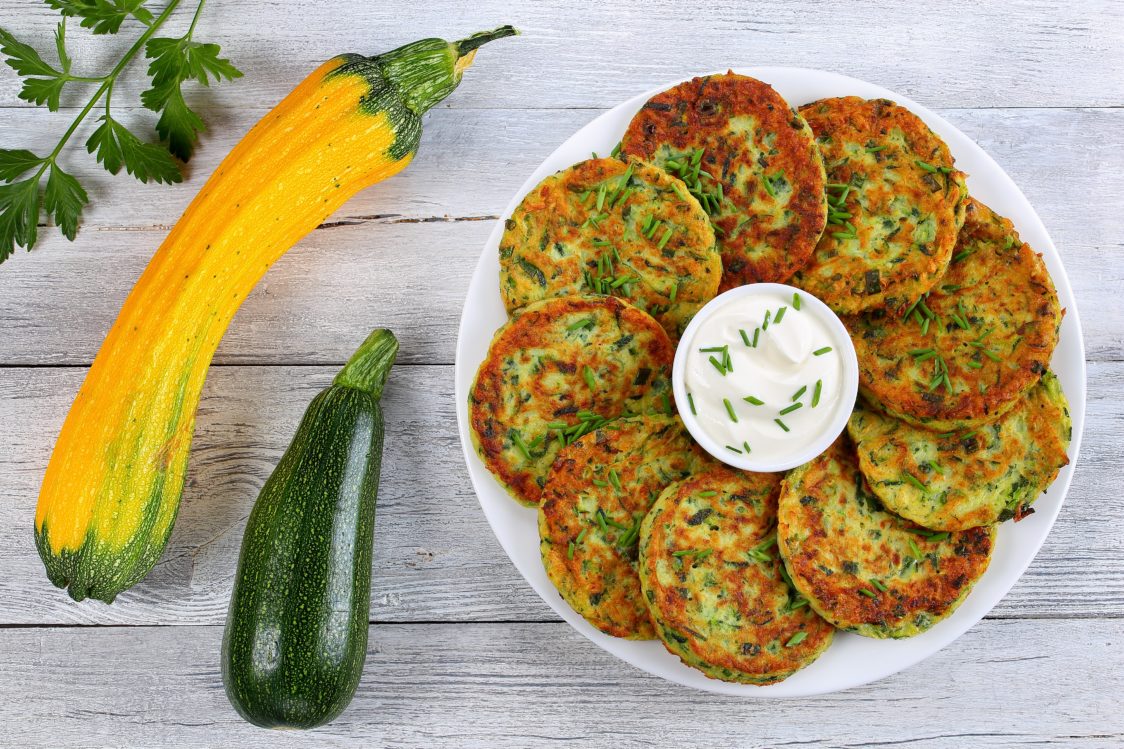
8. Soups
Liquids are typically not very satiating and don’t really prevent hunger. However, soups seem to be an exception. Even research suggests that they can surprisingly effectively fill the stomach, satiate and reduce energy intake from the next course (for example, they help reduce the size of a lunch side dish if the main course is preceded by soup). It is also related to the fact that, thanks to their consistency, they can probably slow down the emptying of the stomach and thus prolong the feeling of satiety. [3]
In order for soups to serve as a good helper in fighting off hunger and reducing overall energy intake, they should ideally have a low energy density. This means that it is recommended to have a soup that mainly contains different types of vegetables, that is, foods with a minimum amount of energy. [3,11]
A portion of vegetable soup, for example as part of lunch, could thus help you lose weight. That’s when you try to consume a lower amount of energy and have a full and satisfied stomach. If the soup does not contain a lot of fat or other energy-rich foods, you don’t have to worry about it significantly increasing your calorie intake.
What kind of soup to prepare?
- The most suitable are soups which are composed mainly of vegetables. It is up to you whether you cook a soup with actual pieces of vegetables or opt for a creamy soup.
- The goal is for the soup to have a low energy density, so don’t add too much oil, cream or other energy-rich foods.
- Of course, soups that contain meat, pasta, legumes or cream also belong in the diet. However, their energy value could already resemble a main course.
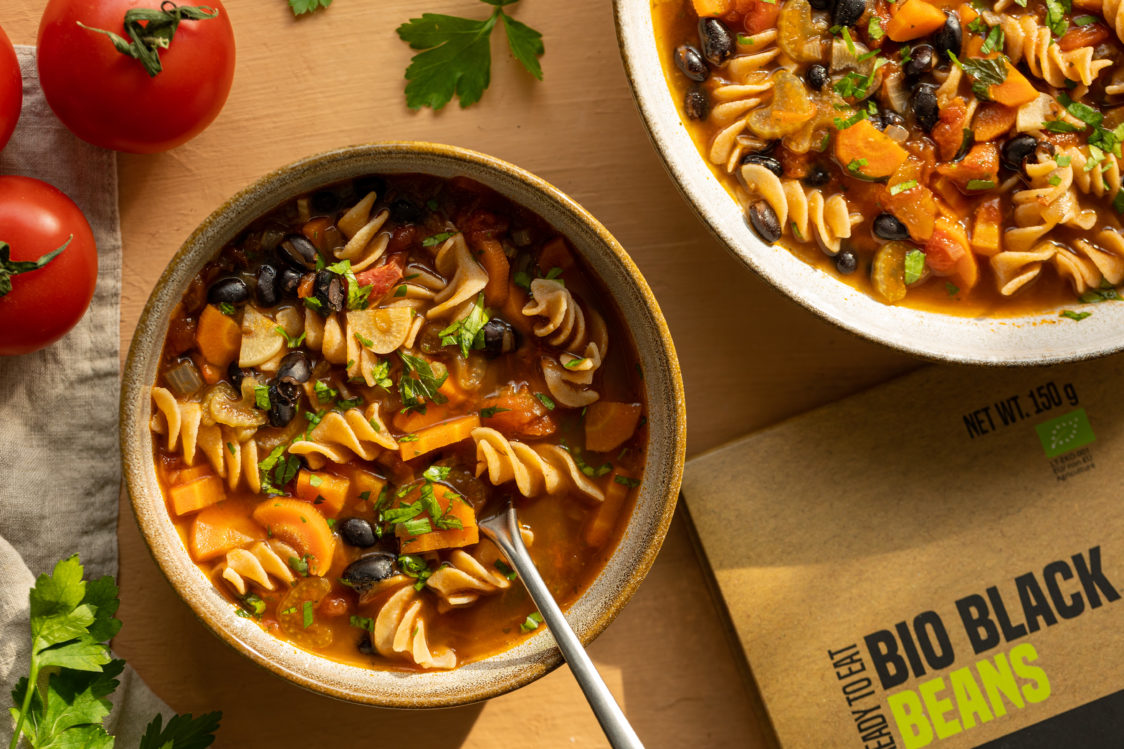
9. Vegetable salads
Similar to the case of soups, vegetable salads can also help you effectively reduce energy intake if you include them in the menu as an appetizer or as a side dish to the main course. Vegetables are rich in water and fibre and have approximately 10-30 kcal per 100 g. Only species with a higher amount of carbohydrates, such as beetroot or carrots, have an energy value of around 40 kcal. [16]
Several studies have looked at the effect of salads with different composition and quantity on the size of subsequently eaten portions. They found that a large serving of salad with a low energy content has the best effect. In practice, this means that the most advantageous for you is a load of fresh vegetables with the lowest possible amount of oil or dressings. It can be, for example, a mixture of leafy salads, cucumber, tomatoes and radish used as a first course during lunch or dinner. [14,15]

How to include vegetable salads in your diet?
- As already mentioned, it seems beneficial to have a larger amount of salad before a main meal, such as lunch or dinner.
- It can also be used as a snack between main meals.
- However, vegetables have a positive effect at any time of the day, so it is definitely beneficial to have them with every meal.
What salad to prepare?
- Prepare a mix of different types of vegetables, such as lettuce, tomatoes, radishes and peppers. There are no limits to your imagination, so you can use any types you like.
- Add a dressing with a lower amount of calories – you can use balsamic vinegar or lemon juice, for example.
- You can also add cereals, pseudo-cereals or legumes as another source of fibre and complex carbohydrates.
- A source of protein (lean meat, fish, etc.) and healthy fats (oils, nuts and seeds) is also suitable for the salad. However, if the salad contains complex carbohydrates, fats and proteins, remember that its energy value is significantly higher than in the case of the vegetables alone.
10. Watermelon
Do you always look forward to the watermelon season? There is probably nothing tastier than a fresh, chilled red watermelon. Many of you will surely be pleased to hear that it is one of those foods that have a low energy density and at the same time are able to satiate well. This is mainly due to the amount of water, which makes up to 91% of its content. [10,16]
Watermelon contains sugar, and therefore one would expect that after eating it, our blood sugar level (glycemia) would rise rapidly. Sugar is generally quickly digested and absorbed and a rapid increase in blood sugar is often followed by a sharp drop, which can cause, for example, sweet cravings. However, the rise in blood sugar after eating watermelon is not so sudden, because the total amount of sugar is relatively low, namely 6 g / 100 g. For comparison, a banana contains 12 g of sugar / 100 g. In addition, if you eat it together with yoghurt or another source of protein, the rise in blood sugar will be even slower. [10,16]
However, this doesn’t mean that you should devour half a watermelon per sitting. Ideally, you should eat 2 servings of fruit (the size of your fist) a day, and watermelon is no exception. [19]
How much energy and nutrients does watermelon contain?
| Energy Value | 33 kcal / 139 kJ |
| Protein | 0.6 g |
| Carbohydrates | 7 g |
| of which sugars | 6 g |
| Fats | 0.15 g |
| Fibre | 0.4 g |
| Water | 91 g |
How to include watermelon in your diet?
- The most advantageous and probably the tastiest is to treat yourself to a watermelon in its original form, just by itself as a small snack during the day or together with yoghurt, quark, etc.
- However, for variety, you can use it in smoothies, or you can use its juice to flavour still or sparkling water.
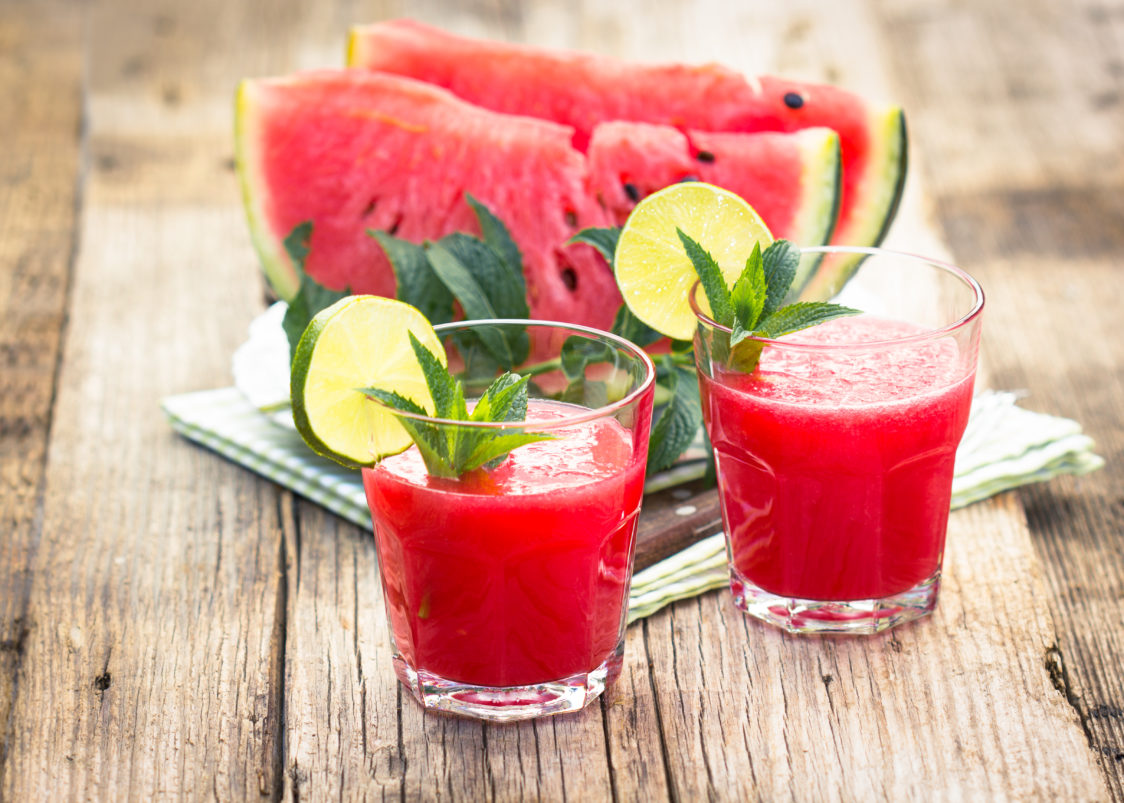
11. Berries
If you are looking for a fruit from which you will receive the least amount of sugar and energy, berries are the right choice. This group includes, for example, the following types:
- Raspberries
- Blueberries
- Currants
- Blackberries
- Strawberries
- Cranberries
These small fruits are also typical in its high content of fibre and water, thanks to which they satiate quite well. In one study, scientists compared the effect of eating berries and cookies on feelings of hunger and subsequent food intake. They found that after eating fruit, energy intake from the next meal was lower, which is probably due to its higher volume and water and fibre content. [9]
Berries are also a great source of antioxidants, such as flavonoids, phenolic acids, vitamin C and vitamin E, which help the body fight free radicals and reduce the risk of various diseases. [5]
How much energy and nutrients do berries contain?
| Energy Value | 46 kcal / 193 kJ | 59 kcal / 248 kJ | 54 kcal / 227 kJ | 32 kcal / 134 kJ |
| Protein | 1.2 g | 0.75 g | 1.4 g | 0.7 g |
| Carbohydrates | 5.5 g | 12 g | 9.5 g | 5.7 g |
| of which sugars | 4.4 g | 9.9 g | 7.4 g | 4.9 g |
| Fats | 0.65 g | 0.3 g | 0.2 g | 0.3 g |
| Fibre | 6.5 g | 2.5 g | 4.3 g | 2 g |
| Water | 86 g | 84 g | 84 g | 91 g |
How to include berries in your diet?
- These tiny fruits taste great in yoghurt or quark with various muesli or granola.
- You can also use them to make delicious desserts, such as these blueberry bars or muffins.
- They are also suitable for smoothies or for flavouring still or mineral water.
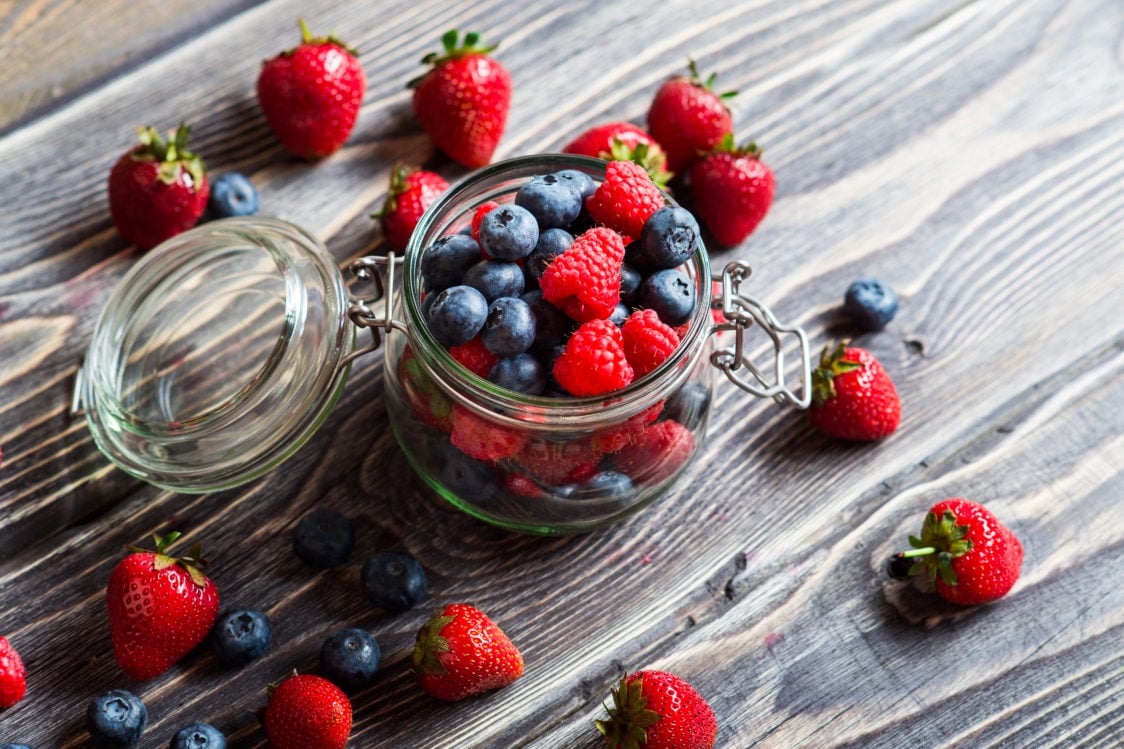
What other foods could be included on this list?
The list of foods that can satiate well and contain only a minimum amount of calories certainly doesn’t end with those we have mentioned so far.
- Other foods that could also be easily included are different types of vegetables, such as cruciferous vegetables (cauliflower, broccoli, cabbage, kohlrabi, etc.), leafy vegetables or fruit vegetables such as cucumbers, peppers or tomatoes.
- Lean types of meat, hams with a high proportion of meat or, for example, dairy products with a lower fat content, generally have a relatively low amount of calories as well.
- Egg whites, which, unlike yolks, only contain proteins, could be included here as well.
- Let’s not forget legumes or whole grain foods. Although their energy value is higher than that of the foods mentioned so far, they are still valued because of their fibre content, complex carbohydrates and proteins.
What should you remember?
Recurrent feelings of hunger don’t belong to a proper diet, not even when you are trying to lose weight. Your goal should always be a varied and balanced menu rich in all nutrients, which also includes foods with a high satiating capacity. These foods usually have a large volume, a high content of water, fibre or protein. If they are a regular part of your meals, you have a much better chance that your attempts to lose weight will go without hunger pangs and cravings and will eventually end in success.
If you found this article useful, don’t keep it to yourself and spread it among your family and friends.
[1] BILSBOROUGH, S. - MANN, N. A review of issues of dietary protein intake in humans. – https://pubmed.ncbi.nlm.nih.gov/16779921/
[2] BORZOEI, S. et al. A comparison of effects of fish and beef protein on satiety in normal weight men.– https://pubmed.ncbi.nlm.nih.gov/16482079/
[3] CLEGG, M.E. et al. Soups increase satiety through delayed gastric emptying yet increased glycaemic response. – https://pubmed.ncbi.nlm.nih.gov/23093339/
[4] COSTA, L.G. Contaminants in fish: risk-benefit considerations. – https://pubmed.ncbi.nlm.nih.gov/17913692/
[5] DEL BO’, C. et al. Berries and oxidative stress markers: an overview of human intervention studies. – https://pubmed.ncbi.nlm.nih.gov/26226324/
[6] DUYFF, R.L. Complete Food & Nutrition Guide. . New York: Academy of Nutrition and Dietetics, 2017. ISBN 978-0-544-52058-5.
[7] EFSA PANEL ON DIETETIC PRODUCTS, NUTRITION AND ALLERGIES (NDA) Scientific Opinion on Dietary Reference Values for calcium. – https://onlinelibrary.wiley.com/doi/abs/10.2903/j.efsa.2015.4101
[8] GELIEBTER, A. et al. Satiety following intake of potatoes and other carbohydrate test meals. – https://pubmed.ncbi.nlm.nih.gov/23221259/
[9] JAMES, L.J. et al. An afternoon snack of berries reduces subsequent energy intake compared to an isoenergetic confectionary snack. – https://pubmed.ncbi.nlm.nih.gov/26162950/
[10] LUM, T. et al. Effects of Fresh Watermelon Consumption on the Acute Satiety Response and Cardiometabolic Risk Factors in Overweight and Obese Adults. – https://www.ncbi.nlm.nih.gov/pmc/articles/PMC6470521/
[11] MATTES, R. Soup and satiety. – https://pubmed.ncbi.nlm.nih.gov/15639159/
[12] NUTRITION, C. for F.S. and A. Mercury Levels in Commercial Fish and Shellfish (1990-2012). – https://www.fda.gov/food/environmental-contaminants-food/mercury-levels-commercial-fish-and-shellfish-1990-2012
[13] ROBERTSON, T.M. et al. Starchy Carbohydrates in a Healthy Diet: The Role of the Humble Potato. – https://www.ncbi.nlm.nih.gov/pmc/articles/PMC6267054/
[14] ROE, L.S. et al. Salad and satiety: the effect of timing of salad consumption on meal energy intake. – https://www.ncbi.nlm.nih.gov/pmc/articles/PMC3264798/
[15] ROLLS, B.J. et al. Salad and satiety: Energy density and portion size of a first-course salad affect energy intake at lunch. – https://www.jandonline.org/article/S0002-8223(04)01132-0/fulltext
[16] USDA FoodData Central. - https://ndb.nal.usda.gov/index.html
[17] Food and Feed Information Portal Database | FIP.– https://ec.europa.eu/food/food-feed-portal/screen/health-claims/eu-register
[18] Fullness FactorTM – NutritionData.com. [https://nutritiondata.self.com/topics/fullness-factor
[19] Hand Portion FAQ: A Guide from Precision Nutrition. – https://www.precisionnutrition.com/hand-portion-faq
[20] The energy density approach - British Nutrition Foundation.– https://www.nutrition.org.uk/putting-it-into-practice/balancing-the-diet/the-energy-density-approach/
[21] S.H.A. Holt at al. A Satiety Index of common foods. – https://www.researchgate.net/publication/15701207_A_Satiety_Index_of_common_foods

